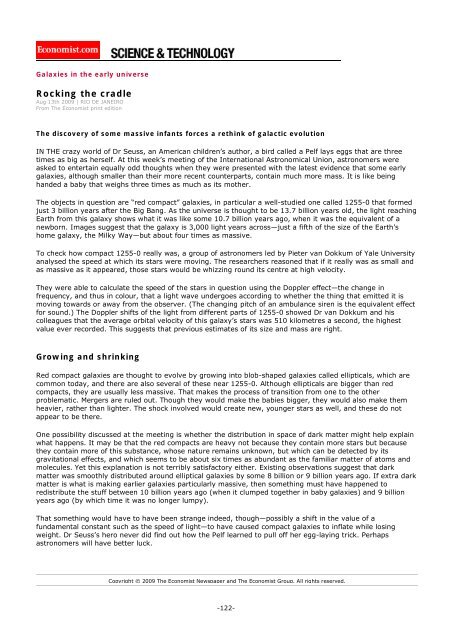Untitled - the ultimate blog
Untitled - the ultimate blog
Untitled - the ultimate blog
You also want an ePaper? Increase the reach of your titles
YUMPU automatically turns print PDFs into web optimized ePapers that Google loves.
Galaxies in <strong>the</strong> early universe<br />
Rocking <strong>the</strong> cradle<br />
Aug 13th 2009 | RIO DE JANEIRO<br />
From The Economist print edition<br />
The discovery of some massive infants forces a rethink of galactic evolution<br />
IN THE crazy world of Dr Seuss, an American children’s author, a bird called a Pelf lays eggs that are three<br />
times as big as herself. At this week’s meeting of <strong>the</strong> International Astronomical Union, astronomers were<br />
asked to entertain equally odd thoughts when <strong>the</strong>y were presented with <strong>the</strong> latest evidence that some early<br />
galaxies, although smaller than <strong>the</strong>ir more recent counterparts, contain much more mass. It is like being<br />
handed a baby that weighs three times as much as its mo<strong>the</strong>r.<br />
The objects in question are “red compact” galaxies, in particular a well-studied one called 1255-0 that formed<br />
just 3 billion years after <strong>the</strong> Big Bang. As <strong>the</strong> universe is thought to be 13.7 billion years old, <strong>the</strong> light reaching<br />
Earth from this galaxy shows what it was like some 10.7 billion years ago, when it was <strong>the</strong> equivalent of a<br />
newborn. Images suggest that <strong>the</strong> galaxy is 3,000 light years across—just a fifth of <strong>the</strong> size of <strong>the</strong> Earth’s<br />
home galaxy, <strong>the</strong> Milky Way—but about four times as massive.<br />
To check how compact 1255-0 really was, a group of astronomers led by Pieter van Dokkum of Yale University<br />
analysed <strong>the</strong> speed at which its stars were moving. The researchers reasoned that if it really was as small and<br />
as massive as it appeared, those stars would be whizzing round its centre at high velocity.<br />
They were able to calculate <strong>the</strong> speed of <strong>the</strong> stars in question using <strong>the</strong> Doppler effect—<strong>the</strong> change in<br />
frequency, and thus in colour, that a light wave undergoes according to whe<strong>the</strong>r <strong>the</strong> thing that emitted it is<br />
moving towards or away from <strong>the</strong> observer. (The changing pitch of an ambulance siren is <strong>the</strong> equivalent effect<br />
for sound.) The Doppler shifts of <strong>the</strong> light from different parts of 1255-0 showed Dr van Dokkum and his<br />
colleagues that <strong>the</strong> average orbital velocity of this galaxy’s stars was 510 kilometres a second, <strong>the</strong> highest<br />
value ever recorded. This suggests that previous estimates of its size and mass are right.<br />
Growing and shrinking<br />
Red compact galaxies are thought to evolve by growing into blob-shaped galaxies called ellipticals, which are<br />
common today, and <strong>the</strong>re are also several of <strong>the</strong>se near 1255-0. Although ellipticals are bigger than red<br />
compacts, <strong>the</strong>y are usually less massive. That makes <strong>the</strong> process of transition from one to <strong>the</strong> o<strong>the</strong>r<br />
problematic. Mergers are ruled out. Though <strong>the</strong>y would make <strong>the</strong> babies bigger, <strong>the</strong>y would also make <strong>the</strong>m<br />
heavier, ra<strong>the</strong>r than lighter. The shock involved would create new, younger stars as well, and <strong>the</strong>se do not<br />
appear to be <strong>the</strong>re.<br />
One possibility discussed at <strong>the</strong> meeting is whe<strong>the</strong>r <strong>the</strong> distribution in space of dark matter might help explain<br />
what happens. It may be that <strong>the</strong> red compacts are heavy not because <strong>the</strong>y contain more stars but because<br />
<strong>the</strong>y contain more of this substance, whose nature remains unknown, but which can be detected by its<br />
gravitational effects, and which seems to be about six times as abundant as <strong>the</strong> familiar matter of atoms and<br />
molecules. Yet this explanation is not terribly satisfactory ei<strong>the</strong>r. Existing observations suggest that dark<br />
matter was smoothly distributed around elliptical galaxies by some 8 billion or 9 billion years ago. If extra dark<br />
matter is what is making earlier galaxies particularly massive, <strong>the</strong>n something must have happened to<br />
redistribute <strong>the</strong> stuff between 10 billion years ago (when it clumped toge<strong>the</strong>r in baby galaxies) and 9 billion<br />
years ago (by which time it was no longer lumpy).<br />
That something would have to have been strange indeed, though—possibly a shift in <strong>the</strong> value of a<br />
fundamental constant such as <strong>the</strong> speed of light—to have caused compact galaxies to inflate while losing<br />
weight. Dr Seuss’s hero never did find out how <strong>the</strong> Pelf learned to pull off her egg-laying trick. Perhaps<br />
astronomers will have better luck.<br />
Copyright © 2009 The Economist Newspaper and The Economist Group. All rights reserved.<br />
-122-








![[ccebbook.cn]The Economist August 1st 2009 - the ultimate blog](https://img.yumpu.com/28183607/1/190x252/ccebbookcnthe-economist-august-1st-2009-the-ultimate-blog.jpg?quality=85)



![[ccebook.cn]The World in 2010](https://img.yumpu.com/12057568/1/190x249/ccebookcnthe-world-in-2010.jpg?quality=85)
![[ccemagz.com]The Economist October 24th 2009 - the ultimate blog](https://img.yumpu.com/5191885/1/190x252/ccemagzcomthe-economist-october-24th-2009-the-ultimate-blog.jpg?quality=85)